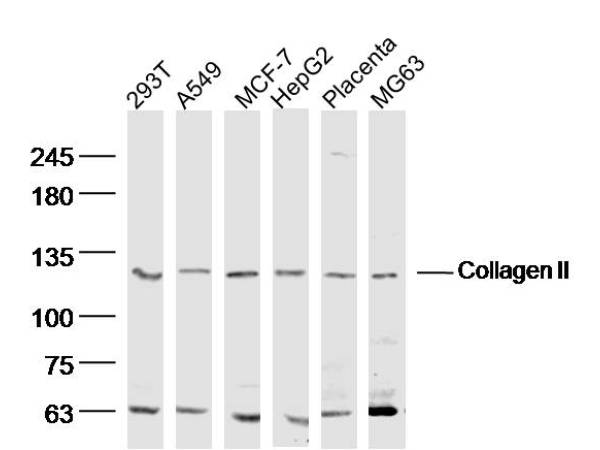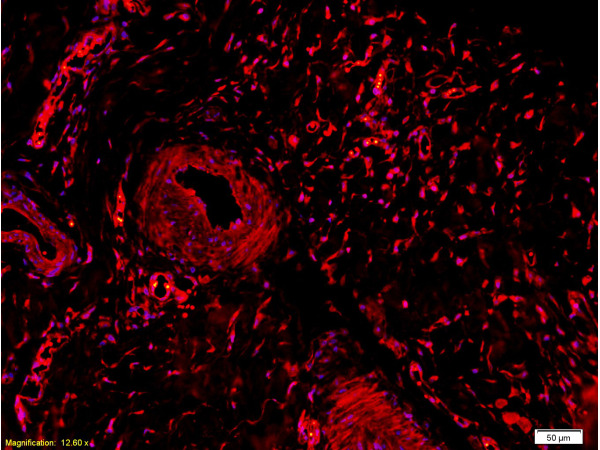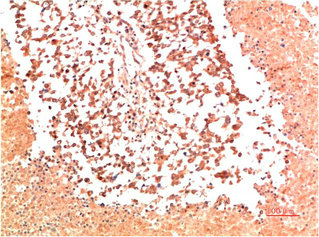
Lane 1: Human 293T lysates; Lane 2: Human A549 lysates; Lane 3: Human MCF-7 lysates; Lane 4: Human HepG2 lysates; Lane 5: Mouse Placenta lysates; Lane 6: Human Mg63 lysates probed with Collagen II Polyclonal Antibody, Unconjugated (bs-0709R) at 1:300 dilution and 4˚C overnight incubation. Followed by conjugated secondary antibody incubation at 1:10000 for 60 min at 37˚C.
Collagen II Polyclonal Antibody
BS-0709R
ApplicationsFlow Cytometry, ImmunoFluorescence, Western Blot, ELISA, ImmunoCytoChemistry, ImmunoHistoChemistry, ImmunoHistoChemistry Frozen, ImmunoHistoChemistry Paraffin
Product group Antibodies
ReactivityBovine, Canine, Chicken, Guinea Pig, Human, Mouse, Porcine, Rabbit, Rat
TargetCOL2A1
Overview
- SupplierBioss
- Product NameCollagen II Polyclonal Antibody
- Delivery Days Customer16
- ApplicationsFlow Cytometry, ImmunoFluorescence, Western Blot, ELISA, ImmunoCytoChemistry, ImmunoHistoChemistry, ImmunoHistoChemistry Frozen, ImmunoHistoChemistry Paraffin
- Applications SupplierWB(1:300-5000), ELISA(1:500-1000), FCM(1:20-100), IHC-P(1:200-400), IHC-F(1:100-500), IF(IHC-P)(1:50-200), IF(IHC-F)(1:50-200), IF(ICC)(1:50-200)
- CertificationResearch Use Only
- ClonalityPolyclonal
- Concentration1 ug/ul
- ConjugateUnconjugated
- Gene ID1280
- Target nameCOL2A1
- Target descriptioncollagen type II alpha 1 chain
- Target synonymsACG2, ANFH, ANFH1, AOM, COL11A3, EDMMD, LCPD, OSCDP, PLSDT, SEDC, SEDSTN, SEMDSTWK, SMDALG, STL1, VPED, collagen alpha-1(II) chain, alpha-1 type II collagen, arthroophthalmopathy, progressive (Stickler syndrome), cartilage collagen, chondrocalcin, collagen II, alpha-1 polypeptide, collagen, type II, alpha 1
- HostRabbit
- IsotypeIgG
- Protein IDP02458
- Protein NameCollagen alpha-1(II) chain
- ReactivityBovine, Canine, Chicken, Guinea Pig, Human, Mouse, Porcine, Rabbit, Rat
- Storage Instruction-20°C
- UNSPSC12352203
References
- Yang J, Tang Y, Chen W, et al. Establishment and characterization of an immortalized human chondrocyte cell line. Biotechnol Lett. 2020,42(5):707-716. doi: 10.1007/s10529-020-02827-yRead this paper
- Zhan X. Effect of matrix stiffness and adhesion ligand density on chondrogenic differentiation of mesenchymal stem cells. J Biomed Mater Res A. 2020,108(3):675-683. doi: 10.1002/jbm.a.36847Read this paper
- Lei J, Fu Y, Zhuang Y, et al. LncRNA SNHG1 alleviates IL-1β-induced osteoarthritis by inhibiting miR-16-5p-mediated p38 MAPK and NF-κB signaling pathways. Biosci Rep. 2019,39(9):pii: BSR20191523. doi: 10.1042/BSR20191523.Read this paper
- Wang D, Zhu H, Cheng W, et al. Effects of hypoxia and ASIC3 on nucleus pulposus cells: From cell behavior to molecular mechanism. Biomed Pharmacother. 2019,117:109061. doi: 10.1016/j.biopha.2019.109061Read this paper
- Zhao R, Wang S, Jia L, et al. Interleukin-1 receptor antagonist protein (IL-1Ra) and miR-140 overexpression via pNNS-conjugated chitosan-mediated gene transfer enhances the repair of full-thickness cartilage defects in a rabbit model. Bone Joint Res. 2019,8(3):165-178. doi: 10.1302/2046-3758.83.BJR-2018-0222.R1Read this paper
- Han Y, Qu P, Zhang K, et al. Storage solution containing hydrogen improves the preservation effect of osteochondral allograft. Cell Tissue Bank. 2019,20(2):201-208. doi: 10.1007/s10561-019-09758-7Read this paper
- Wang HC, Lin YT, Lin TH, et al. Intra-articular injection of N-acetylglucosamine and hyaluronic acid combined with PLGA scaffolds for osteochondral repair in rabbits. PLoS One. 2018,13(12):e0209747. doi: 10.1371/journal.pone.0209747Read this paper
- Zhou H, Shen J, Hu Z, et al. Leukemia inhibitory factor promotes extracellular matrix synthesis in degenerative nucleus pulposus cells via MAPK-ERK1/2 signaling pathway. Biochem Biophys Res Commun. 2018,507(1-4):253-259. doi: 10.1016/j.bbrc.2018.11.018Read this paper
- Chen X, Qin Z, Zhao J, et al. Pulsed Magnetic Field Stimuli Can Promote Chondrogenic Differentiation of Superparamagnetic Iron Oxide Nanoparticles-Labeled Mesenchymal Stem Cells in Rats. J Biomed Nanotechnol. 2018,14(12):2135-2145. doi: 10.1166/jbn.2018.2644Read this paper
- Chen CH, Kuo CY, Chen JP. Effect of Cyclic Dynamic Compressive Loading on Chondrocytes and Adipose-Derived Stem Cells Co-Cultured in Highly Elastic Cryogel Scaffolds. Int J Mol Sci. 2018,19(2). doi: 10.3390/ijms19020370Read this paper





